
HMAS Duchess was a Daring-class destroyer that served in the Royal Navy as HMS Duchess from 1952 to 1964, and in the Royal Australian Navy (RAN) from 1964 to 1980. She was laid down by John I. Thornycroft and Company, and commissioned into the Royal Navy in 1952.
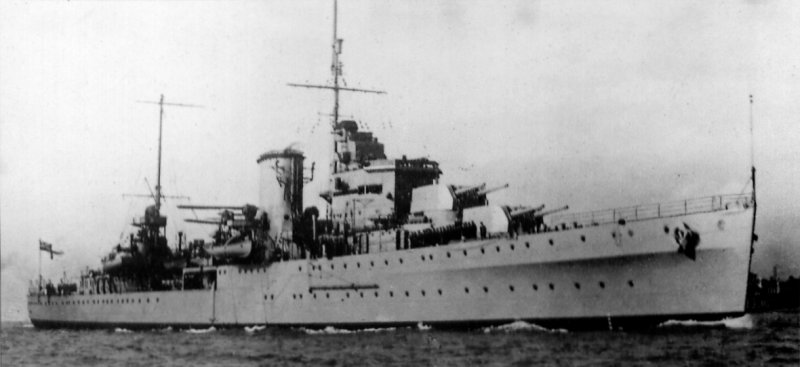
HMS Ajax was a Leander-class light cruiser which served with the Royal Navy during World War II. She became famous for her part in the Battle of the River Plate, the Battle of Crete, the Battle of Malta and as a supply escort in the siege of Tobruk. This ship was the eighth in the Royal Navy to bear the name. In February 1942, she was adopted by the civil community of Halifax.
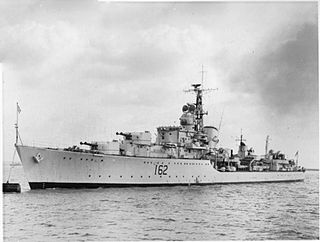
HMS Jutland (D62) was a later or 1943 Battle-class fleet destroyer of the United Kingdom's Royal Navy. She was named after the Battle of Jutland, the largest naval battle of the First World War. The first Jutland was launched in 1945, but was cancelled that same year. Her sister ship, Malplaquet - named after a battle between Britain and France during the War of the Spanish Succession in 1709 - was renamed Jutland just prior to her launch on 20 February 1946, and was commissioned on 30 July 1947. The original Jutland was finally broken up in 1957 at Rosyth.
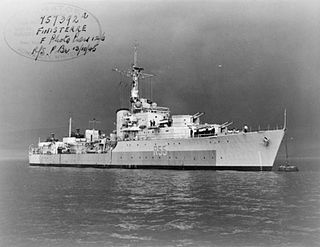
HMS Finisterre was a Battle-class destroyer of the Royal Navy (RN). She was named after one of the battles of Cape Finisterre. She was the first and thus far the only ship of the Royal Navy to bear this name.

HMS Camperdown was a Battle-class destroyer of the Royal Navy (RN). She was named after the Battle of Camperdown, a naval engagement between the British and Dutch that took place in 1797, and which resulted in a British victory.

HMS Agincourt (D86) was a later or 1943 Battle-class fleet destroyer of the Royal Navy. She was named in honour of the Battle of Agincourt, fought in 1415 during the Hundred Years' War. Agincourt was built by R. & W. Hawthorn, Leslie & Company Limited on the River Tyne. She was launched on 29 January 1945 and commissioned on 25 June 1947.
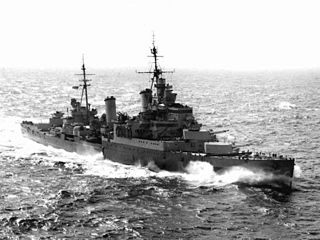
HMS Sheffield was one of the Southampton sub class of the Town-class cruisers of the Royal Navy during the Second World War. She took part in actions against several major German warships. Unlike most Royal Navy ships of her time, her fittings were constructed from stainless steel instead of the more traditional brass. This was an attempt to reduce the amount of cleaning required on the part of the crew. Her nickname, the "Shiny Sheff", stemmed from this. A prototype radar system was placed into service in August 1938 on the Sheffield. It was the first vessel in the Royal Navy to be so equipped.

BAPFerré(DM-74) was a Daring-class destroyer in service with the Peruvian Navy from 1973 to 2007. She was built by Yarrow Shipbuilders and completed for the Royal Navy in 1953 as HMS Decoy (D106).

HMS Swiftsure was one of three Minotaur-class light cruisers built for the Royal Navy during the Second World War. She was laid down by Vickers Armstrong at Newcastle upon Tyne on 22 September 1941, launched on 4 February 1943 by Lady Wake-Walker and commissioned on 22 June 1944. The first of a new Minotaur class, a development of the later Colony class with extra beam and a fifth twin 4 inch turret. Swiftsure was the last Royal Navy cruiser completed during World War II and was the first British cruiser designed around the concept of an operations room and modern radar, with sensor screens and communications positioned for efficient operation. During her service in the Pacific in 1945, she proved the most efficient anti-aircraft cruiser in the fleet, and was the first Royal Navy cruiser with the 274 lock-and-follow radar targeting system for her main armament.
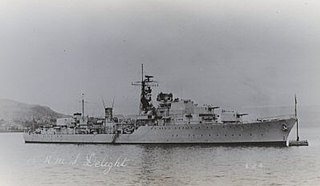
HMS Delight was a Daring-class destroyer of the British Royal Navy, launched in 1950 as the Royal Navy's first all-welded warship, and broken up at Inverkeithing in 1971.

HMS Roebuck was an R-class destroyer of the British Royal Navy that saw service during World War II. She was the fifteenth ship to carry this traditional ship name, after a small deer native to the British Isles, which was used as far back as the reign of Queen Elizabeth I.

HMS Rocket was an R-class destroyer of the Royal Navy that saw service during Second World War. Built by Scotts Shipbuilding and Engineering Company in Greenock, Scotland, she was launched in October 1942 and commissioned in August 1943.

HMS Relentless was an R-class destroyer of the Royal Navy that saw service during World War II. She was later converted into a Type 15 fast anti-submarine frigate, with the new pennant number F185.

HMS Venus was a V-class destroyer of the Royal Navy that saw service during the Second World War. She was built by Fairfield Shipbuilding and Engineering Company, of Govan, Scotland and launched on 23 February 1943.

HMS Virago was a V-class destroyer of the British Royal Navy that served in World War II. She was later converted into a Type 15 fast anti-submarine frigate, with the new pennant number F76.

HMS Wakeful was a W-class destroyer of the Royal Navy launched in 1943. She saw service during the Second World War and was later converted into a Type 15 fast anti-submarine frigate. She was sold for scrap in 1971.

HMS Redoubt was an R-class destroyer built for the Royal Navy during the Second World War.

HMS Apollo was an Abdiel-class minelayer of the Royal Navy, the eighth RN ship to carry the name. She served with the Home Fleet during World War II, taking part in the Normandy Landings before being transferred to the British Pacific Fleet. Put into reserve in 1946, she was recommissioned in 1951, serving until 1961, and was sold for scrapping in 1962.

HMS Obdurate was an O-class destroyer of the Royal Navy. She was built by William Denny and Brothers of Dumbarton, being laid down at their yards on the River Clyde on 25 April 1940, launched on 19 February 1942 and commissioned on 3 September 1942.

HMS Obedient was an O-class destroyer of the Royal Navy. She was built by William Denny and Brothers of Dumbarton, between 1940 and 1942. During Warship Week in 1942 she was adopted by the civil community of Lymington, United Kingdom. She was scrapped in 1962.





















